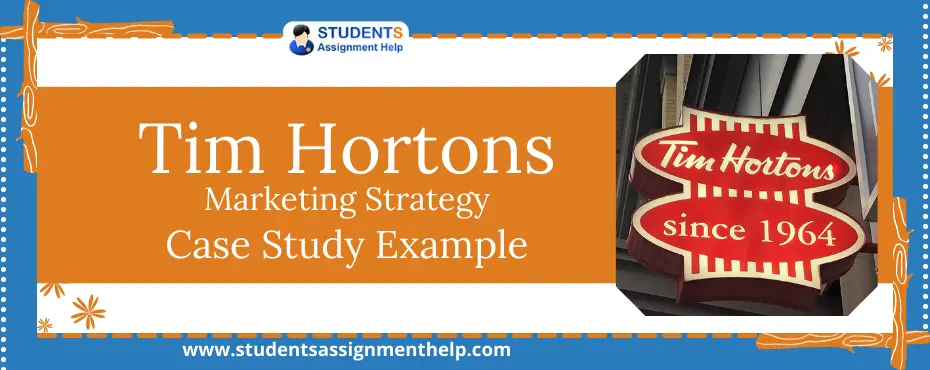Tim Hortons Marketing Strategy Case Study Example

Headquartered in Toronto, Tim Horton is a Canadian restaurant chain that’s known for serving delicious and flavorful fast food. Tim Horton established the business with Montreal Business Jim charade. In 1995, an American fast-food chain Wendy’s bought Tim Horton. The partnership lasted till 2006.
A Brazilian firm, 3G Capital bought Tim Horton in 2014. It became a subsidiary of the Restaurant Brand International.
Though it’s owned by a foreign business enterprise, Canadian culture exists in Tim Horton. Initially, it offered only doughnuts and coffee. Other than hot chocolate, doughnuts, and coffee, the store offers backed products as well. The menu enlists specialty products like iced coffee, iced cappuccinos, and flavored cappuccinos.
Mision of Tim Hortons
The guiding mission of Tim Hortons is to provide superior quality services and products to the community, and customers through innovation, partnerships, and leadership.
Tim Horton wishes to establish itself as a market leader in the fast-food industry, achieving super quality while maintaining its value, standards and delivering healthy food.
The vision of Tim Hortons
Tim Hortons wants to establish itself as an industry leader in all the activities in which it participates.
Tim Horton aims to excel in the food industry, develop innovative products and improve existing services. It strives to give its 100% through passion, and determination.
Flexible Rates Compatible With Everyone’s Budget
Hire a Professional Essay & Assignment Writer for completing your Academic Assessments
Objectives of Tim Horton
- To make sure that it provides customers with the quality of food that they deserve.
- Produce and deliver high-quality food and services with immense dedication and effort.
- Achieve success and excellence, providing services consistently to the delight of customers.
Marketing Strategy of Tim Hortons
A marketing mix is a combination of the tactics and strategies to implement the marketing plan. It aims to boost the competitiveness of Tim Hortons against an array of market players. It helps the company to place itself as an industry leader.
Process followed by Tim Horton
Tim Horton follows several simple business processes. Customers enter the restaurant, place an order at the counter, and pay for it. Tim Horton cafes are self-service stores, which require the customers to collect their orders from the counter itself.
The service includes food prepared at the store and the staff that handle store operations and processes the order.
Physical Evidence of Tim Horton
Physical evidence revolves around the fact that the brand is of great pride to people residing in Canada. As such, it speaks of a success story of Canadians. People have a sense of belonging as they get treated with friendliness and love.
Food quality is too good for the price charged at the store. The quality of service is recommendable. The aesthetics of the naturally sourced food items makes them palatable and demanding among the customers.
The store offers cozy seating facilities that contribute to the physical evidence of the store and enhance your dining experiences.
Buy high-quality essays & assignment writing as per particular university, high school or college by UK, USA & Australian Writers
Marketing Mix of Tim Horton
Tim Hortons Marketing Mix analyzes the 4 Ps and explains the marketing strategy.
Competitive analysis in Marketing Mix
According to market analysis of Tim Hortons, sustainability in the food industry depends on price, product quality, convenience, speed of service, easy accessibility, and atmosphere prevailing inside the store. Other factors that add value to the brand include brand acceptance, the attractiveness of facilities, and the number of outlets.
Tim Horton faces tough competition in the market. Fast-service restaurants, beverage and pastry restaurants, and convenience stores selling snacks compete with the Canadian restaurant chain. Tim Horton has local competitors (Paul Café, The Coffee Bean, La Gaufrette) and international challengers ( Gloria Jean’s, Dunkin’ Donuts, Starbucks, Second Cup).
Products in Marketing Mix
Tim Horton is a global restaurant chain based in Toronto, Canada. It is known for serving a comprehensive range of beverages and snacks. Tim Hortons strategy analysis shows that it specializes in food items like pancakes, lattes, strudel, donuts, coffee, and more. The Canadian restaurant chain has three types of coffee including dark roast, decaf, and original.
The breakfast menu incorporates oatmeal, croissants, hash browns, sandwiches, and bagel. Based on Tim Hortons expansion strategy, it also serves baked food items like pastries, yogurts, bagels, cookies, donuts, and muffins.
Pricing Strategy of Tim Hortons
Significance of cost gets lowered when the factors like, for example, quality and reliability of products/service provided equals or exceeds the value the purchaser is paying for the product. The Canadian Fast-food chain targets the masses and offers a comprehensive range of products and/or services.
It does so that more people can afford services and/or products offered by Tim Horton. There is a slight difference in the product pricing, which gives it an in comparison to Dunkin Donuts and Starbucks. A cup of coffee served at the Tim Horton restaurant costs you $ to $2. It depends on the size of the cup.
Cookies will cost you $0.89. Donuts come for $ 0.99, whereas the sandwiches are priced at $ 2.5. Cold beverages are priced between $1.5 to $ 3. Hot beverages come at $ 2 to $ 5.
Place in Marketing Mix
Tim Horton international strategy includes 4613 stores, and about 3436 stores are based in North America. Customers can opt to buy products from the official website of Tim Hortons. Coffee grinds manufactured by the company are available at Amazon for sale.
Tim Hortons market segmentation
The demographic segmentation will require Tim Hortons to divide market according to demographic characteristics, like- gender, age, income and ethnicity.
Tim Hortons main target audience is business people and working adults, families and students from lower and middle class. It markets its brand toward families with young children through the sponsored sports teams and free community swim and skate days.
Purchase Solved Case Study From Studentsassignmenthelp.Com
Purchase solved case study of Tim Hortons Marketing Strategy from our case study writers. We have been a professional pioneer for years in writing case studies, for students they always approach us for writing their case studies and we never let them down, we always provide plagiarism-free work and give assurance that they will definitely get the best grades and appreciation from their professors.
And if you are looking for strategic marketing assignment help? If yes, then you are good to go, our Assignment help US provide all types of assignments like marketing, economics, management, nursing, and many more and at the best price as we are well aware that most of our students are learners, so we charge a reasonable amount.
You can check our website for other examples and samples of case studies like Next Plc Case Study Example, Dunkin Doughnuts Marketing Strategy Case Study, Burger King Case Study Example, Lenovo Strategy Case Study Solution, Zara Marketing Strategy Case Study Example, and many others.
Stuck with a lot of homework assignments and feeling stressed ?
Take professional academic assistance & Get 100% Plagiarism free papers

